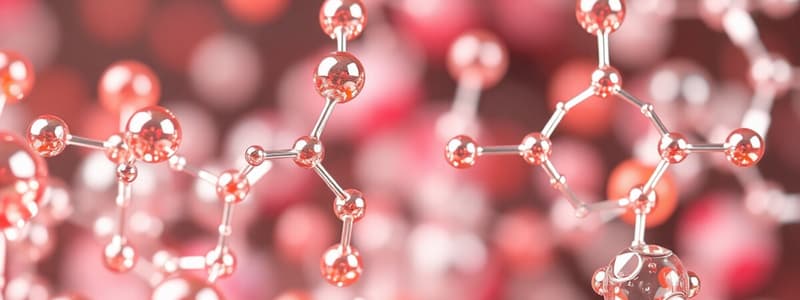Podcast
Questions and Answers
The ______ ion is composed of one oxygen atom and one hydrogen atom.
The ______ ion is composed of one oxygen atom and one hydrogen atom.
hydroxide
The ______ ion contains one nitrogen atom and three oxygen atoms.
The ______ ion contains one nitrogen atom and three oxygen atoms.
nitrate
The ______ ion is important in the formation of rocks and minerals.
The ______ ion is important in the formation of rocks and minerals.
carbonate
The ______ ion is widely prevalent in minerals, such as gypsum.
The ______ ion is widely prevalent in minerals, such as gypsum.
The ______ ion is a crucial constituent of DNA and RNA.
The ______ ion is a crucial constituent of DNA and RNA.
Flashcards
Hydroxide Ion
Hydroxide Ion
(OH⁻)
Nitrate Ion
Nitrate Ion
(NO₃⁻)
Carbonate Ion
Carbonate Ion
(CO₃²⁻)
Sulfate Ion
Sulfate Ion
Signup and view all the flashcards
Phosphate Ion
Phosphate Ion
Signup and view all the flashcards
Ammonia
Ammonia
Signup and view all the flashcards
Study Notes
Polyatomic Ions: Introduction
- Polyatomic ions are charged groups of two or more atoms bonded together.
- They act as a single unit with a net positive or negative charge.
- They are common in chemical compounds and their naming follows specific rules.
Hydroxide Ion (OH⁻)
- Composed of one oxygen atom and one hydrogen atom.
- A negatively charged polyatomic ion.
- Common in bases and many ionic compounds.
- Important in acid-base reactions and solubility of metal hydroxides.
Nitrate Ion (NO₃⁻)
- Consists of one nitrogen atom and three oxygen atoms.
- A negatively charged polyatomic ion.
- Frequently found in various chemical compounds, including fertilizers.
- Commonly involved in oxidation-reduction (redox) reactions.
Carbonate Ion (CO₃²⁻)
- Composed of one carbon atom and three oxygen atoms.
- A negatively charged polyatomic ion with a 2- charge.
- Important in the formation of rocks and minerals.
- Found in various compounds, including baking soda.
- Plays a vital role in the carbon cycle.
Sulfate Ion (SO₄²⁻)
- Contains one sulfur atom and four oxygen atoms.
- A negatively charged polyatomic ion with a 2- charge.
- Widely prevalent in minerals, such as gypsum.
- Essential in many biological processes.
- Common in various industrial applications and environmental contexts.
Phosphate Ion (PO₄³⁻)
- Contains one phosphorus atom and four oxygen atoms.
- A negatively charged polyatomic ion with a 3- charge.
- Crucial constituent of DNA and RNA.
- Present in various minerals and fertilizers.
- Participates in important biological processes.
General Naming Conventions
- Polyatomic ions have specific names that must be memorized.
- The names are often used directly when describing chemical compounds.
- For example, sodium sulfate is Na₂SO₄. The polyatomic sulfate ion is a key part of the name and formula. This is a crucial concept to understand in chemistry.
Studying That Suits You
Use AI to generate personalized quizzes and flashcards to suit your learning preferences.




